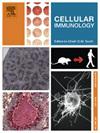Chloroquine treatment ameliorates experimental autoimmune encephalomyelitis by inhibiting T cell differentiation and pDC accumulation
IF 2.9
4区 医学
Q2 CELL BIOLOGY
引用次数: 0
Abstract
Objectives
Chloroquine (CQ) has been used to treat rheumatoid arthritis and systemic lupus erythematosus, but its use in multiple sclerosis (MS) is limited by side effects and insufficient efficacy. To enhance treatment outcomes, understanding CQ's therapeutic mechanisms in MS is crucial. Thus, we administered CQ to mice with experimental autoimmune encephalomyelitis (EAE) and investigated its disease-ameliorating effects and underlying cellular mechanisms.
Methods
CQ was applied intraperitoneally six days after EAE induction, immune responses, with a focus on inflammatory and regulatory T cells, as well as dendritic cells in blood, lymph nodes, spleen, and bone marrow were analyzed by flow cytometry.
Results
CQ treatment significantly reduced cumulative disease score and maximal disease score in CQ-treated group. Immunohistochemical analysis of the spinal cords confirmed the reduced demyelination after CQ treatment, which is accompanied by significantly decreased infiltration of T cells, B cells, and macrophages, and less activated microglia cells. Flow cytometry analysis of peripheral lymphoid organs revealed a significant decrease of inflammatory Th17 cells, which is associated with reduced pDC and their IFN-α expression, as well as Treg cells in CQ-treated mice. Indeed, depletion of pDC alone or simultaneously with CQ treatment significantly reduced EAE severity.
Conclusion
Our results demonstrated that CQ treatment inhibits the development of EAE disease on one hand by enhancing the expansion of Treg in dLN and spleen, and on the other hand by inhibiting the accumulation of pDC and their IFN-α expression in the spleen and bone marrow. This joint effort restricts the level of inflammation in peripheral and later in CNS. Furthermore, developing a pDC-targeted CQ treatment will not only increase the treatment efficiency, but also largely decrease side effects.
氯喹治疗通过抑制T细胞分化和pDC积累改善实验性自身免疫性脑脊髓炎
目的氯喹(chloroquine, CQ)已被用于治疗类风湿性关节炎和系统性红斑狼疮,但其在多发性硬化症(multiple sclerosis, MS)中的应用受到副作用和疗效不足的限制。为了提高治疗效果,了解CQ在多发性硬化症中的治疗机制至关重要。因此,我们将CQ给予实验性自身免疫性脑脊髓炎(EAE)小鼠,并研究其疾病改善作用和潜在的细胞机制。方法在EAE诱导后第6天腹腔注射scq,流式细胞术分析各组小鼠的免疫反应,重点观察炎症和调节性T细胞,以及血液、淋巴结、脾脏和骨髓中的树突状细胞。结果cq治疗组累积疾病评分和最大疾病评分显著降低。脊髓免疫组化分析证实,CQ治疗后脊髓脱髓鞘减少,T细胞、B细胞、巨噬细胞浸润明显减少,活化小胶质细胞减少。外周淋巴器官的流式细胞术分析显示,cq处理小鼠炎症性Th17细胞和Treg细胞显著减少,这与pDC及其IFN-α表达减少有关。的确,单独使用pDC或同时使用CQ治疗可显著降低EAE的严重程度。结论CQ治疗一方面通过增强dLN和脾脏中Treg的扩增,另一方面通过抑制脾脏和骨髓中pDC的积累及其IFN-α的表达来抑制EAE疾病的发展。这种共同的努力限制了外周和中枢神经系统的炎症水平。此外,开发针对pdc的CQ治疗方法不仅可以提高治疗效率,还可以大大减少副作用。
本文章由计算机程序翻译,如有差异,请以英文原文为准。
求助全文
约1分钟内获得全文
求助全文
来源期刊

Cellular immunology
生物-免疫学
CiteScore
8.20
自引率
2.30%
发文量
102
审稿时长
30 days
期刊介绍:
Cellular Immunology publishes original investigations concerned with the immunological activities of cells in experimental or clinical situations. The scope of the journal encompasses the broad area of in vitro and in vivo studies of cellular immune responses. Purely clinical descriptive studies are not considered.
Research Areas include:
• Antigen receptor sites
• Autoimmunity
• Delayed-type hypersensitivity or cellular immunity
• Immunologic deficiency states and their reconstitution
• Immunologic surveillance and tumor immunity
• Immunomodulation
• Immunotherapy
• Lymphokines and cytokines
• Nonantibody immunity
• Parasite immunology
• Resistance to intracellular microbial and viral infection
• Thymus and lymphocyte immunobiology
• Transplantation immunology
• Tumor immunity.
 求助内容:
求助内容: 应助结果提醒方式:
应助结果提醒方式:


